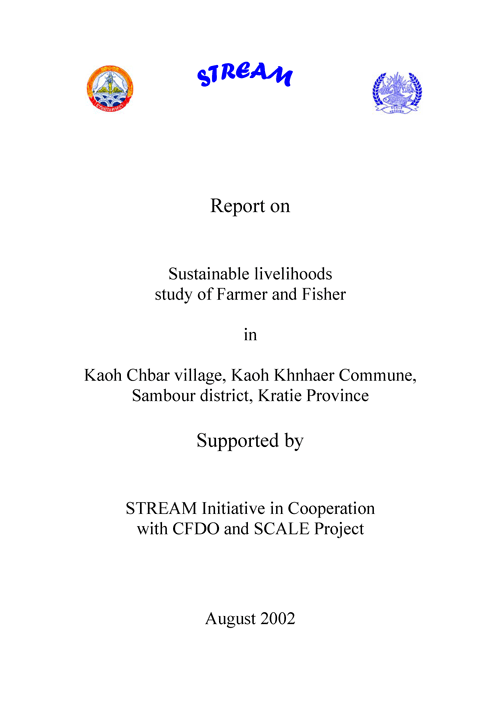Report on sustainable livelihoods study of farmers and fishers in Kaoh Chbar Village, Kratie Province, Cambodia
1 August 2002 | 881 Downloads | .pdf | 571.39 KB | Cambodia, Gender, Livelihoods, gender and social issues
This study of the livelihood of farmers and fishermen is based on the information provided by the villagers. The study team facilitated and encouraged the villagers to share their knowledge and raise the real problems related to their livelihood. The study team subsequently recorded the information and their findings to compile a report.
This study was undertaken between 13th to 18th August 2002. The team worked with 15 to 30 villagers who volunteered to participate in the discussion. This number of participants is to represent 142 households in the village. Due to the differences in material ownership, means of production and standard of living the villagers divided themselves into 4 wealth ranking groups: rich, medium, poor and very poor. The main assets in the village were divided into 5 groups: human, natural, financial, infrastructure and social.
There were three groups of people and institutions that had relationships with villagers. They were government staff, businesses and civil society group. These groups shared different roles and impacts on villagers.
There had been some changes that impacted on the livelihood of villagers, especially in natural resources. The population is constantly growing which leads to an increase in natural resource utilization and ultimately their degradation. The villagers usually suffer from diseases such as malaria, fever and dengue fever. The poor people lack suitable tools especially draft animals. In general the price of produce is 50% lower than the market price in the town.
Their problems include poor transportation, inadequate marketing to sell produce, flooding, lack of draft animals and deficiency in agronomy knowledge. Furthermore both human and animals face diseases. The team facilitated discussions with villagers to rank the problems and analyse the root cause and effects. This resulted in an action plan designed to prevent and treat animal and human diseases and form an animal bank.
Conclusions The issues and problems discovered during the period of study in Kaoh Chbar village enabled the team to reach some conclusions on the current situation and recommendations for the future. It was felt that the villagers worked well together, and their leaders were easy for the outside to contact and co-operate with. The growth in population meant that natural resources were being degraded. The infrastructure of the village is poor so their produce price is low. The poor households suffered from diseases and shortfall of food.
It was suggested that they should receive advice related to health issues, investigate agricultural possibilities, manage the community fishery in a sustainable manner and provide credit in the form of cows or buffalos to help the poor households.
This publication is also available in Khmer.
Creative Commons Attribution.

